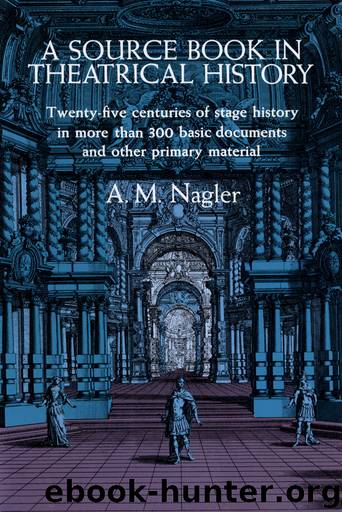A Source Book in Theatrical History by Nagler A. M.;

Author:Nagler, A. M.;
Language: eng
Format: epub
Publisher: Dover Publications
Published: 1959-12-08T16:00:00+00:00
Ferdinando Galli-Bibiena: Design for a Harbor.
Giuseppe Galli-Bibiena: Palatial Hall.
Who does not now perceive of what importance it is that the painter’s imagination should be regulated by learning and guided by a correct judgment? To this will greatly contribute the perusal of authors and conversation of learned men well skilled in the customs of antiquity. But the artist should have recourse to no person preferably to the poet, the author of the Opera, who, we are to suppose, has preconceived in his mind every article; and to have omitted nothing that can help to embellish, or make the action he has chosen to exhibit, appear probable.
Although the painters of the fifteenth century are, without doubt, the most excellent, yet the art of scene-painting received considerable improvements in the last age, and the obvious reason is, the many theatres, then erected, gave occasion to that species of painting to become more common; whence it necessarily followed, that a greater number of ingenious persons, applying themselves to it, have brought it nearer to perfection.
The devised contrivances of Girolamo Genga (extolled so much by Serlio) to make, in the theatre of Urbino, trees, &c. of the finest silk, would now-a-days be classed among the childish baubles that adorn the manger, in the shews of Christ’s nativity. It is farther my opinion, that Serlio, from whose treatise upon scenery there may nevertheless some good hints be taken, did not sufficiently consider how, without the assistance of relievos in wood, we might conquer all the difficulties of perspective; and how, in very confined situations, we could represent the appearance of extensive space; but to such a pitch the science of deceiving the eye has been improved in our time. The introduction, especially, of accidental points, or rather the invention of viewing scenes by the angle, produces the finest effects imaginable; but that requires the nicest judgment to bring properly into practice. FERDINANDO BIBIENA was the inventor of those scenes, which, by the novelty of the manner, drew the eyes of all the curious upon him. They soon began to look upon, as unpleasing objects for a stage, those streets, and narrow passages, those galleries that were always made to tend to its center, there at once to limit the spectator’s imagination and sight.
He had studied the principles of his art in Vignola under good masters: moreover, being endowed with a picturesque and animating fancy, he came to a resolution of giving a meaning to his scenes, after the same manner as had been done before him, by the painters of the fifteenth century, to the figures of Bellini, Peruzzi, and Mantegna.
Ferdinando Bibiena was the Paul Veronese of the theatre; and, like him, he enjoyed the glory of raising his art to the summit, so far as relates to the magnificent, and to a certain degree of the marvellous. He had the luck too, like Veronese, of not establishing it by the pupils reared up under him. They employed all their pains in imitating the easiest part
Download
This site does not store any files on its server. We only index and link to content provided by other sites. Please contact the content providers to delete copyright contents if any and email us, we'll remove relevant links or contents immediately.
Call Me by Your Name by André Aciman(20351)
Ready Player One by Cline Ernest(14497)
How to Be a Bawse: A Guide to Conquering Life by Lilly Singh(7364)
Wiseguy by Nicholas Pileggi(5650)
The Kite Runner by Khaled Hosseini(5062)
On Writing A Memoir of the Craft by Stephen King(4847)
Audition by Ryu Murakami(4822)
The Crown by Robert Lacey(4710)
Call me by your name by Andre Aciman(4600)
Gerald's Game by Stephen King(4556)
Harry Potter and the Cursed Child: The Journey by Harry Potter Theatrical Productions(4429)
Dialogue by Robert McKee(4306)
The Perils of Being Moderately Famous by Soha Ali Khan(4156)
Dynamic Alignment Through Imagery by Eric Franklin(4100)
Apollo 8 by Jeffrey Kluger(3621)
Seriously... I'm Kidding by Ellen DeGeneres(3564)
The Inner Game of Tennis by W. Timothy Gallwey(3557)
How to be Champion: My Autobiography by Sarah Millican(3544)
Darker by E L James(3463)
